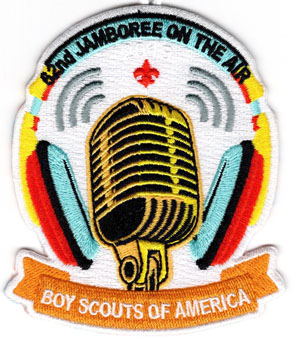
A Foxhunting Jamboree

From my January 1997 Homing In column in 73 Magazine. "The fox people are here!"
When did you first hear about radio direction finding (RDF)? Since it has become a tool for finding downed aircraft and stolen cars, today's school kids probably get a vague notion of it early on. Sadly, they aren't told that it can also be great fun for them.
A recent e-mail exchange with Tom Stewart K3TS brought back memories of my introduction to RDF. Tom wrote a classic article about two-meter hidden transmitter hunting in New Jersey for the September 1957 issue of QST. I was 10 years old at the time and studying for my ham ticket, faithfully trying to copy W1AW code practice every night on my drifty Hallicrafters S-38D receiver. That QST issue was one of my first ham radio magazines. Tom's tales of T-hunt trickery got me eager to try the sport.
When my Novice license arrived the following spring, I agitated at the radio club in our town of 11,000 souls to get the group to hold some hidden transmitter hunts. Even though Novices had two-meter phone privileges at the time, we were a hundred miles from the nearest two-meter activity and there were no repeaters to bridge the gap.
Finally, the club scheduled a hunt on 75 meter AM, where most mobile operating was done in those days. I somehow managed to lash together a two-tube 75-meter converter with vibrator power supply and connect it to the broadcast receiver in the family's gas-guzzler convertible. Of course I had to talk Dad into driving. Bemused by the whole thing, he agreed.
For an RDF antenna, I used the multi-turn flat loop from the back cover of an old table model broadcast set. I hadn't learned enough RF theory to do a good job of resonating and coupling it, so it wasn't very sensitive or directional. Dad and I did a lot of riding around just trying to hear a signal over the ignition noise. Fortunately, the hunt boundaries were small and gas was cheap.
Hundreds of T-hunts later, I still think it is the most fun you can have in ham radio. I wish every youngster could experience it. But how many kids nowadays have supportive radio clubs and patient fathers to Elmer them into it? How can we bring kids and RDF together? I think Homing In readers Greg and Gabriella Owens have found an answer.
Greg and Gabriella's letter arrived shortly after Labor Day 1996. They were in charge of a committee from the Simi Settlers Radio Club that would be hosting a Scout Jamboree-on-the-Air (JOTA) campout. They wanted to know how to put on a demonstration of foxhunting (also called radio-orienteering and ARDF) as part of their JOTA activities. What an opportunity!
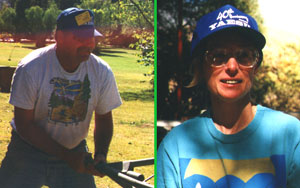
JOTA is a worldwide ham event, held annually in mid-October for almost 40 years. Having never been in Scouts, I knew very little about it. I had no idea if foxhunting had ever been done there before. (Actually, I'm still not sure.) Either way, I knew that this opportunity couldn't be passed up, so I called them immediately.
JOTA celebrations run for a 48-hour period beginning Friday afternoon. They range from simple to elaborate. In some towns, a ham invites a troop or two for a hamshack visit, letting Scouts participate in contacts with other JOTA groups. In other places, it's a full-blown Camporee with many stations and activities. That's what the Settlers were planning.
"We hope to have stations on every active HF and VHF band," Gabriella told me. "We'll demonstrate both voice and CW modes on the air. Local ATVers will set up two stations so the Scouts can have television QSOs back and forth. We will also have code oscillator kits for them to solder together."
The Simi Settlers JOTA site would be Lake Casitas Recreation Area near scenic Ojai, California. Scouts from Ventura, Los Angeles, and Santa Barbara counties were invited. Several hundred could be accommodated. The event would officially begin at noon Saturday and continue for 24 hours. Many Scouts would camp over Saturday night, while others would be at the lake shore for just a few hours on one day. Foxhunting at night would be unsafe, so we had to make it possible for many Scouts to hunt at the same time during our limited available hours.
Lake Casitas is a drive of over 100 miles for T-hunters in my area, but it is only about 40 miles from Santa Barbara, where there is a growing group of radio-orienteering enthusiasts. I own plenty of fox transmitters, but not enough RDF gear for dozens of Scouts to use. What's more, April and I would need knowledgeable helpers for one-on-one training of the Scouts. I zipped off e-mail to Marvin Johnston KE6HTS of the Santa Barbara Amateur Radio Club and he immediately agreed to help.
Having no experience with foxhunting demonstrations for pre-teens, I could only try to envision how it would go. I imagined that we would take the Scouts in packs or troops of a dozen or two and give them a quick show-and-tell on RDFing and map plotting. Then we would hand out some gear and send them into the woods to try to find five foxes transmitting for a minute each in sequence, just like they do in a formal international-rules competition.
Greg surveyed topographical maps for the site and suggested a hilly area of about one square mile across the park road from the camping area. He even agreed to make lots of copies of that map for the Scouts. "Don't worry," he told me, "they are prepared for being in the woods and will bring compasses with them." Good, all I would need for orienteering would be a batch of protractors.
For a week before the event, I spent each evening tuning up my RDF sets and borrowing more. On Friday afternoon, April and I went to the site to check it out. I quickly realized that my imagination had not served me well. The hilly area was fenced off. No access! Oh well, it wasn't very shady. In truth, it looked like a barren home for rattlesnakes. Besides, it was too far away from the campsite.
We decided to hide the foxes within the large wooded JOTA campground, not far from our van where we were showing a video of international radio-orienteering competitions. Scouts would not have a long hike. We could easily watch and help. As a side benefit, the sight of them combing the grounds with sniffing gear would attract much more attention to our demonstration.
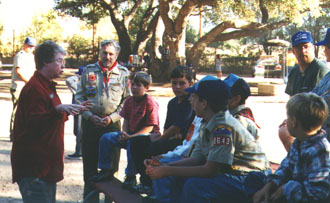
The two hundred or so Scouts that came to Lake Casitas were mostly in elementary schools. They may be champs at the latest video games, but they had to start at square one when it came to RDF. No way could we simply slap gear into their hands and send them out. It worked best to guide them along in groups of two or three as they learned. One Scout at a time used the RDF set while the others watched. It would then be their turns to find the next foxes.
Five cycling intermittent transmitters proved to be too confusing during the learning process. We changed two of them to be continuous emitters on separate frequencies below 146 MHz, just for first-timers. One was in a surplus ammunition box while the other was the cleverly camouflaged "stud T" (see Homing In for October 1996). That one always got looks of amazement when the Scouts flushed it out. As time and equipment permitted, those who did well on continuous foxes could try to bag the intermittent ones on 146.565 MHz.
To regular users of VHF-FM, it's easy to gauge the strength of incoming signals by the amount of background hiss, or lack of it (quieting). But to a Cub Scout who has never held a handi-talkie before, it's not obvious. After some practice, a few of them did well at getting bearings with an HT, beam and active attenuator. Others couldn't seem to get the hang of it, especially if the HT didn't have an S-meter.
Other types of RDF sets were much easier for kids to learn. The Santa Barbara group brought several dual-dipole homing sets (TDOA type) with left-right indication (meter or LEDs). Although TDOAs are more prone to multipath bearing errors and they lacked signal strength indication, the kids found them easy to learn and had good results.
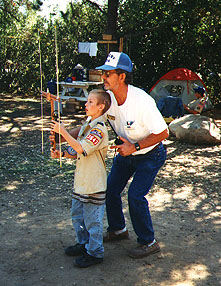
In Europe and Asia, where radio-orienteering is a popular sport in schools, everyone uses special amplitude-based RDF sets for two meters. There are many variations, but they all incorporate a yagi or phased array antenna and a built-in receiver with wide-range RF gain control. Signal strength is indicated by a panel meter, tone pitch, or tone loudness.
I had only two of these foreign-made sets along, but I think they were easiest for Scouts to learn to use. All they had to do was turn the antenna for strongest signal indication and walk that way. Their excitement grew as signal strength rose and they had to lower the RF gain; it meant they were closing in. Bearings were nearly always accurate.
Weight was the biggest disadvantage of the integrated receiver/antennas. It surprised me how difficult it was for some grade-schoolers to hold a 3-element 2-meter yagi overhead long enough to hunt down a hidden fox. Their arms would become fatigued in about three minutes and the beam would slip down to shoulder high. Of course that adversely affected the beam's sensitivity and directivity. In the future, I want to have lighter antennas with masts, so they can easily be held overhead.
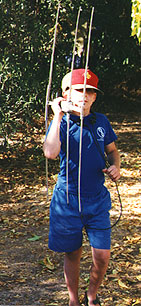
Competitive foxhunters prefer using earphones to hear fox modulation and strength tones in noisy surroundings. That's why most foreign-made integrated receiver/antennas don't have speakers. But phones aren't ideal for one-on-one training. My solution was to have the trainee wear them around the neck instead of over the ears. With gain turned up, they put out enough audio for the trainer, the trainee, and observers to hear. As a bonus, this eliminated the chance of an audio blast directly into the ears if the RF gain control was improperly set when the fox came on the air.
ARDF and kit building were smash hits at our JOTA operation. Lots of Scouts were beeping away on their newly built code oscillators as they came up to the foxhunting display. Some older Scouts said they'd had lots of HF QSOs in previous years, so they were glad have some new activities this time.
Most Scouts had an opportunity to track at least one fox Saturday afternoon. Darkness fell around 6 PM and it was time for a big spaghetti dinner around the campfire. Then we left them for the night, promising to charge up the fox batteries for more hunts the next day.
If there was any doubt that foxhunting enthralled the Scouts, it was dispelled Sunday morning. As we pulled into the campground, we were greeted with young voices shouting, "The fox people are here!" Before we could get the RDF gear out, were mobbed. Scouts who had hunted on Saturday wanted to try again, because the foxes were all in new locations. We gave first priority to those who had not gotten a chance to hunt Saturday; then we let the rest have at it again.
Hats off to the Simi Settlers Radio Club for going beyond the call of duty in providing a special JOTA experience for the Scouts. Special kudos to Greg and Gabriella for paving the way for ARDF events. Also thanks to foxhunting enthusiasts from the Santa Barbara Amateur Radio Club for helping. In addition to Marvin, they were Stephen Nelson KD6VEX, Nerella Reginato, Reg Reginato KE6ZQY, Brian Peddicord KF6DZN, Mike Peddicord KE6OTM, Scott Phillips KF6EDD, Hubert Stamps KC6NAH, Bib Ummels KE6WYA, and President Darryl Widman KF6DI.
Many Scout officials at JOTA-96 expressed interest in future foxhunting demos and activities for their dens, troops, and packs. Given enough inexpensive equipment and trained leadership, radio-orienteering could become a mainstream Scouting activity. I have lots of ideas for gear. But will Scouting organizations across the country be able to find enough T-hunters to get this program off the ground?
Are you Homing In readers willing to build and stockpile some kid-proof ARDF gear, seek out your local Scout leaders, and put on training sessions? I want to hear constructive opinions and ideas from both T-hunters and Scout leaders about this concept. Let's prove that we mean it when we say we want more young people involved in ham radio activities.
From my January 2001 Homing In column in 73 Magazine. There were more Scouts in an urban setting, so we did it a bit differently.
In Orange County, California, the annual Jamboree-On-The-Air (JOTA) on October 21, 2000 was bigger and better than ever. Over 870 Scouts descended on Rancho Alamitos High School in Garden Grove to participate in 13 ham radio exhibits, including HF, VHF, ARES, RACES, ATV, APRS/Packet, CW and hidden transmitter hunting. I put ten foxboxes on the school grounds, ranging from easy-to-spot ammunition cans in the bushes to a tiny micro-T taped on the pipes under a water fountain.
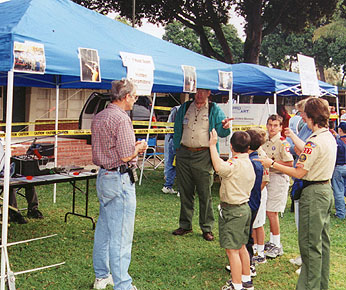
None of the Scouts had ever tried this activity before, so they all needed some quick training. Fortunately, I had some expert helpers, including Tom Curlee WB6UZZ (at left in photo above), co-author of our book on RDF. Also helping was 15-year-old Jay Thompson W6JAY (in photo below) and his father Richard WA6NOL. Both had just returned from the ARDF World Championships in China, where Jay had competed in the Junior Division.
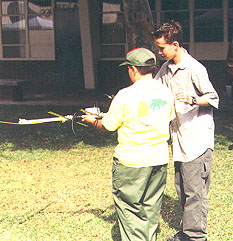
Scouts usually arrived at our foxhunting booth in groups of two or three, sometimes more. We found that a good way to start explaining RDF to them was to point out how it's used to find Emergency Locator Transmitters of downed aircraft. The techniques are similar to those used by biologists tracking radio-tagged animals in nature TV shows that most Scouts have seen.
After seeing how the RDF gear works, one Scout from the group was selected to track a transmitter as the others followed. The youthful hunter got continuous help and encouragement, of course. When he found it, another Scout was selected to find another ammo-can fox nearby. The last hunter of the group, who had received the benefit of watching all the others' mistakes, got to find a well-disguised micro-T for a surprise ending.
For demonstration hunts like this, it's best if the fox transmitters are on different frequencies and run continuously, or nearly so. A simple beam, offset attenuator and a scanner or handi-talkie with S-meter works well, because the instructor and everyone in the group can hear the signal and see the meter. This also demonstrates how simple and inexpensive an on-foot RDF setup can be. "Tape measure" yagis are safest for children to carry. Success for every Scout is the goal, so don't make it too hard.
From my Summer 2006 Homing In column in CQ-VHF Magazine. Foxhunting for all in the Santa Ynez Valley.
Last year, I had the privilege of helping members of the Santa Barbara Amateur Radio Club (SBARC) put on an ambitious JOTA campout weekend for seven Scout troops at the Sedgwick Reserve. This 6000-acre wilderness area in the Santa Ynez Valley of California is owned by the University of California at Santa Barbara and is the site of frequent "digs" by UCSB archeologists such as Michael Glassow KK6NP and Anabel Ford KC6GWA.
In charge of the 2005 SBARC JOTA was Darryl Widman KF6DI, a former Scoutmaster and Scout Commissioner who promised to give the youngsters a comprehensive Amateur Radio experience. For two days, Scouts built their own code oscillators from kits and discovered CW with them. They made contacts on the air, sent television pictures, and learned all about RDF. After completing each activity, they earned stars to put on their individual JOTA cards, marking progress toward their radio merit badges.
SBARC President Marvin Johnston KE6HTS was in charge of the RDF aspects of JOTA 2005. He was assisted by SBARC member Scott Moore KF6IKO and your columnist. Our goal was to help the Scouts successfully complete a one-kilometer round-trip ARDF course on the two-meter ham band. Following International Amateur Radio Union rules, these foxes transmitted for one minute each in rotating sequence, but there were only three of them. Scouts would take the course in teams of two or three, for safety and to help build teamwork skills.
KE6HTS set that 3-fox ARDF course, but before the Scouts were ready for it, they had to become proficient at RDF by going after some practice foxes that I put out around the camp site. There were lots of them, on different frequencies so that multiple teams could be learning without following each other around. Marvin, Scott and I led the self-appointed teams of Scouts in their personalized training.
The first fox was always very close and easy to locate. The next was more difficult, and so on. Each member of the team took a turn at taking bearings with one of the RDF sets, which consisted of a steel-tape yagi and a synthesized Sniffer 4 from Bryan Ackerly VK3YNG in Australia. The audible signal strength indicator and automatic attenuation system of the VK3YNG unit make it ideal for beginners. One of the Scouts was in a motorized wheelchair, so there were some foxes that he could find by himself.
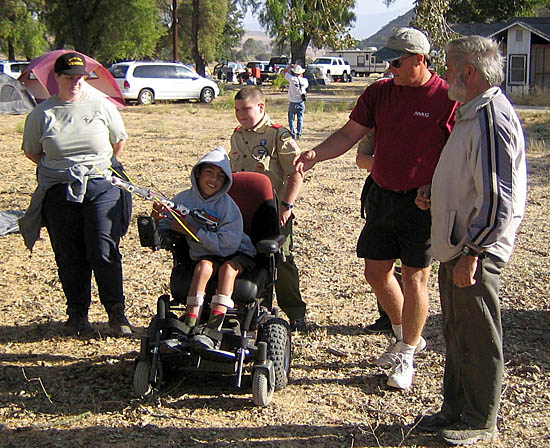
By the time the team members had tracked down three or four transmitters, they were ready to go out on the ARDF course. Working together, they determined which of the three foxes to find first. Usually one Scout did the RDF while the other team members beat the bushes and marked the punch cards at the foxes. Then the fastest one raced back to the finish line with the card.
Stars for their JOTA cards were presented to all who completed the course. The fastest team on the ARDF course received special recognition around the campfire Saturday night.
In his wrap-up report after JOTA 2005, KF6DI wrote, "Some of the Scouts said that the transmitter hunt was the best part of all and that it was the most fun. You should have seen them running back to the starting point so as to beat the times of the other teams. They were really into this!"
Wouldn't it be great if RDF became a part of JOTA activities all across the country? Now is the time to talk to the clubs that will be putting on JOTA events in your area about selecting locations that are ARDF-friendly.
From my April 2015 Homing In column in CQ Magazine. It was "Jamboree by the Sea."
For almost twenty years, I have taken every opportunity to spend JOTA with one or more Scout troops as they discover the joys of finding transmitters on foot. In 2014, the invitation came from Curtis Watanabe KI6KUK to provide foxhunts for about two hundred Scouts at Cabrillo Youth Center in San Pedro, California on the Saturday of JOTA. Some would be camping overnight, but all would be there during the day, when they would also spend time on the air as third parties at several stations that were being set up for the occasion.
The Youth Center is 7.3 acres right on the waterfront with a pier, a fine beach and low vegetation. There were plenty of places to hide my chalkboard-eraser-sized transmitters, but we would only have the daylight hours because it would be unsafe for Scouts to hunt at night in that terrain.
I enlisted help from Marvin Johnston KE6HTS and Tom Gaccione WB2LRH, who brought RDF gear for Scouts to use. Each of us took Scouts out in pairs or trios to seek out my eight transmitters, all on different two-meter frequencies, which I concealed on the grounds early that morning. Often a parent would tag along to watch.
The first Scout of each group would try to find an "easy" transmitter nearby while the others watched. Once he or she found it, then another Scout would try to find another transmitter, perhaps a little more difficult, and so forth. If they did very well, the group might get to seek one or more "bonus" foxes. Having eight transmitters out there meant that Marvin's group wasn't trying to find the same one at the same time as my group, and so forth.
For rapid training and the best experience for the Scouts, the three of us used Sniffer MK4 RDF receiver sets by Bryan Ackerly VK3YNG. These "blue boxes" are ideal for two-meter on-foot transmitter hunting because they have audible tone-pitch signal strength indication and automatic signal attenuation. Frequencies are readily programmed and the unit mounts easily on the back of a measuring-tape antenna. Scouts learn to use them quickly.
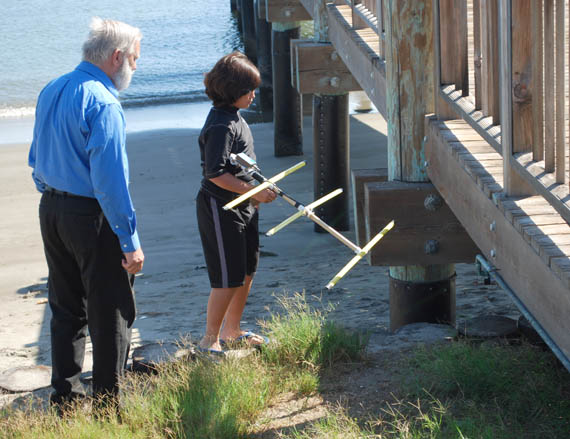
While we were out with the Scouts, my wife April WA6OPS was back at the starting table setting up the next groups of hunters and giving them an introduction into how transmitter hunting is done. We didn't time anyone or have any head-to-head competitions, because there were just too many Scouts and we wanted every Scout at the center to have a foxhunting experience, even if brief.
It was non-stop for all of us, all day long. I encourage you to do something similar for JOTA in your locality this year, but be warned that Cub Scouts have boundless energy. You'll need to be fit to keep up with them for a full day of foxhunting.
More information about planning for JOTA is in this page at K2BSA.net.
Text and photos Copyright ©1996, 2000, 2006 and 2015 Joseph D. Moell. All rights reserved.
 Go to International-Style Foxhunting Comes To The Americas -- How we're getting the ball rolling
Go to International-Style Foxhunting Comes To The Americas -- How we're getting the ball rolling
Go to Latest Championship Foxhunting News -- Stories of recent ARDF events and announcements of upcoming ones
Go to Equipment Ideas for Radio-Orienteering -- Simple and inexpensive receiving and transmitting solutions
Go to Radio Foxhunting in southern California -- Announcements of upcoming demonstration/practice sessions and results of recent local events
Go to Extenders Aid Handicapped Foxhunters -- A novel way to include persons with disabilities
Back to the Homing In home page
This page updated 27 October 2019